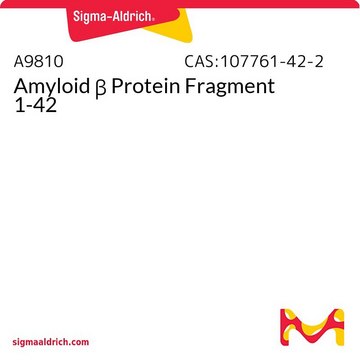459620
Okadaic Acid sodium salt
≥98% (TLC), solid,film (colorless), protein phosphatase 2A and protein phosphatase 1 inhibitor, Calbiochem®
Synonym(s):
Okadaic Acid, Sodium Salt
About This Item
Recommended Products
Product Name
Okadaic Acid, Sodium Salt, Water-soluble analog of Okadaic Acid. Inhibits protein phosphatases 1 and 2A.
Quality Level
Assay
≥98% (TLC)
form
solid
manufacturer/tradename
Calbiochem®
storage condition
OK to freeze
protect from light
color
white to off-white
solubility
water: 1 mg/mL
DMSO: 20 mg/mL
ethanol: 20 mg/mL
shipped in
ambient
storage temp.
−20°C
General description
Biochem/physiol Actions
Warning
Other Notes
Kiguchi, K., et al. 1994. Cell Growth Differentiation5, 995.
Ohaka, Y., et al. 1993. Biochem. Biophys. Res. Commun.197, 916.
Gopalakrishna, R., et al. 1992. Biochem. Biophys. Res. Commun.189, 950.
Kreienbuhl, P., et al. 1992. Blood80, 2911.
Normura, M., et al. 1992. Biochemistry31, 11915.
Song, Q., et al. 1992. J. Cell Physiol.153, 550.
Tada, Y., et al. 1992. Immunopharmacol.24, 17.
Cohen, P., et al. 1990. Trends Biochem. Sci.15, 98.
Cohen, P. 1989. Annu. Rev. Biochem.58, 453.
Cohen, P., and Cohen, P.T.W. 1989. J. Biol. Chem.254 21435.
Haystead, T.A. et al. 1989. Nature337, 78.
Legal Information
Signal Word
Danger
Hazard Statements
Precautionary Statements
Hazard Classifications
Acute Tox. 3 Dermal - Acute Tox. 3 Inhalation - Acute Tox. 3 Oral - Skin Irrit. 2
Storage Class Code
6.1C - Combustible acute toxic Cat.3 / toxic compounds or compounds which causing chronic effects
WGK
WGK 3
Certificates of Analysis (COA)
Search for Certificates of Analysis (COA) by entering the products Lot/Batch Number. Lot and Batch Numbers can be found on a product’s label following the words ‘Lot’ or ‘Batch’.
Already Own This Product?
Find documentation for the products that you have recently purchased in the Document Library.
Our team of scientists has experience in all areas of research including Life Science, Material Science, Chemical Synthesis, Chromatography, Analytical and many others.
Contact Technical Service








